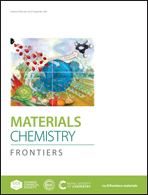Highly sensitive detection of paraquat with pillar[5]arenes as an aptamer in an α-hemolysin nanopore†
Abstract
Recently, biological nanopore-based techniques have attracted more and more attention in the field of single-molecule detection because they allow real-time, sensitive, high-throughput analysis. Herein, we report an engineered biological nanopore sensor by introducing a macrocyclic host molecule carboxylatopillar[5]arene (CP[5]A) that acts as an aptamer into the lumen of a mutant (E111R/K147R)7 αHL nanopore for detecting highly toxic paraquat (PQ) via host–guest interactions at the single-molecule level. By taking advantage of introducing positively charged arginine (Arg) into the lumen of the αHL nanopore, our engineered nanopore sensor exhibits higher stability. More importantly, this nanopore sensor shows high sensitivity, and the limit of detection (LOD) for PQ can reach a nanomolar level of 0.37 ppb. The CP[5]A-based nanopore sensing strategy developed in this work may bring inspiration for single-molecule detection and hold great potential in public health applications.
![Graphical abstract: Highly sensitive detection of paraquat with pillar[5]arenes as an aptamer in an α-hemolysin nanopore](/en/Image/Get?imageInfo.ImageType=GA&imageInfo.ImageIdentifier.ManuscriptID=D1QM00875G&imageInfo.ImageIdentifier.Year=2021)
- This article is part of the themed collection: 2021 Materials Chemistry Frontiers HOT articles


 Please wait while we load your content...
Please wait while we load your content...